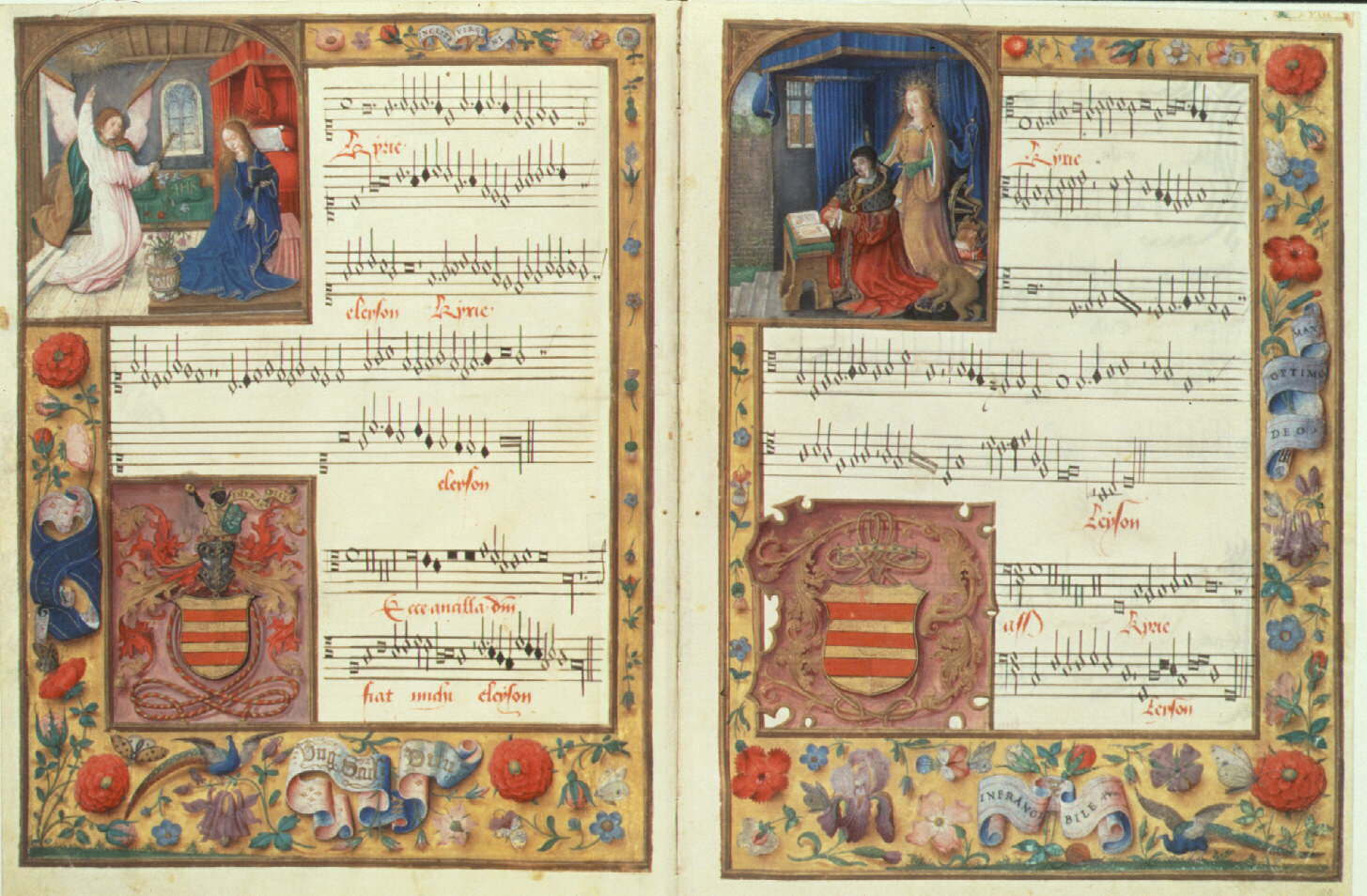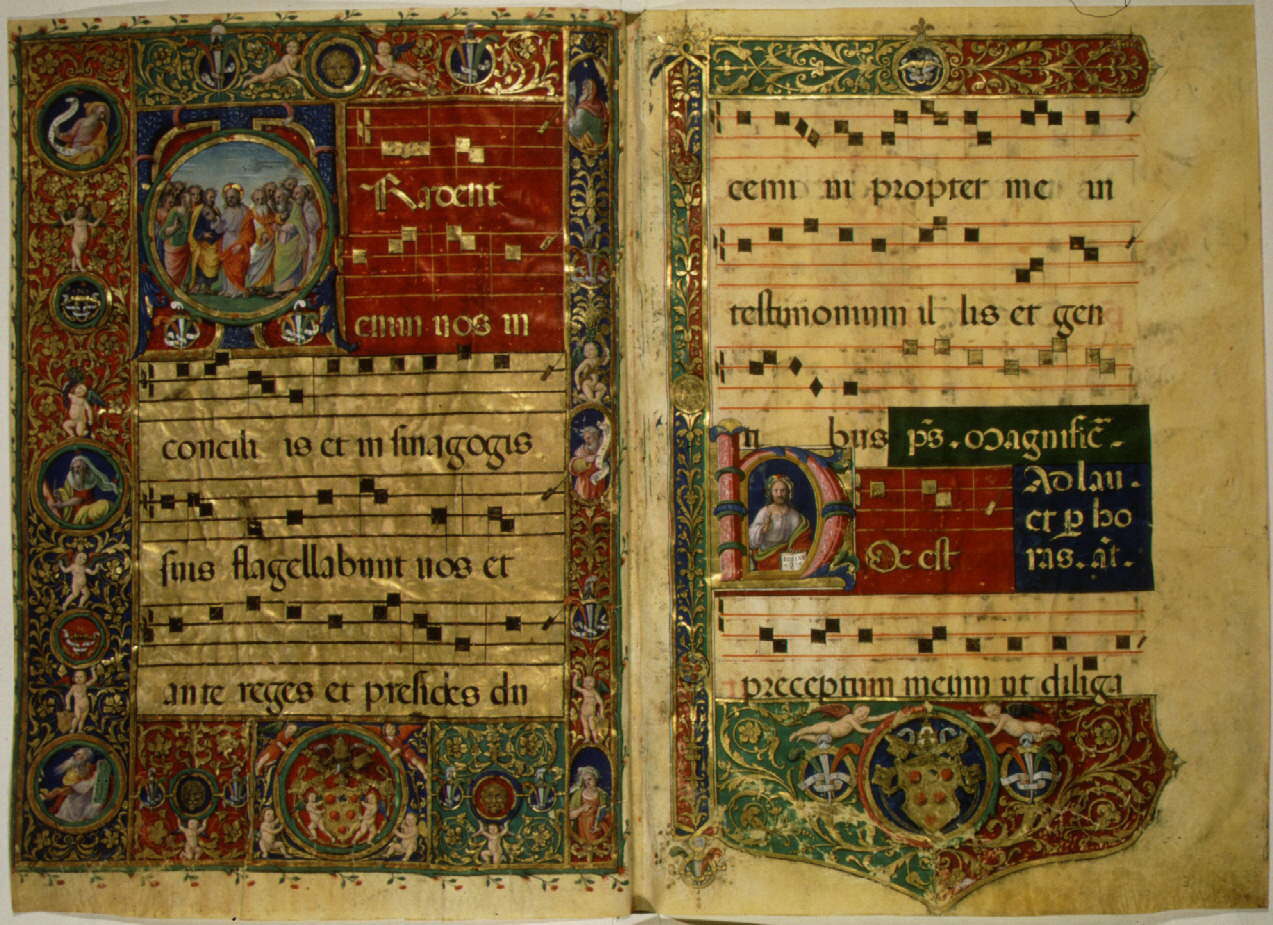MUSIC 210 -- MEDIEVAL AND RENAISSANCE MUSIC
Prof. Stephen Kelly
N.B. Winter Term, 1998
 |
Music Hall 314
Phone: x-4355
Email: "skelly"
|
 |
Texts
Required
- Grout and Palisca, A History of Western Music. 5th ed.
- Palisca Norton Anthology of Western Music. v.1 (NAWM)
On Reserve
- McKinnon, Antiquity and the Middle Ages.
- Strunk, Source Reading in Music History.
- Neuls-Bates, Women in Music. (in folder WIM)
- Weiss and Taruskin, Music in the Western World. (MWW)
Statement on Grading
I realize it is a cliche but I do regard everyone in this class as an equal partner in the pursuit of wisdom. This belief requires that we all come to class and come prepared. Though your letter grade will most directly reflect your performance on the various papers, projects, and exams, the quality of your classwork will also be taken into consideration. If you ever have any questions about grading, or you want to talk about anything else, please do not hesitate to see me. I would like to eliminate all chances of misunderstanding and ill-feeling.
Assignments are to be done before class. N.B. Classes with written assignments are marked with an asterisk *.
Syllabus
- l/5 Introduction and video tape "The Medieval Monastery"
- l/7 The Roman Liturgy and Chants of the Mass c. ll00
- Bergeron, "The Virtual Sacred"
- l/9 Chants of the Office*
- Transcription of Introit and Alleluia from the Third Mass for Christmas (NAWM 3). See
Grout, 38-40 and Parrish (in folder )for help. How would you describe the musical style of the chants you have transcribed?
- l/12 Chant Extensions/Chant Rhythm
- Strunk, 71-75: Jerome, Augustine
- Brunner, "The Performance of Plainchant"
- Blackley, Liner notes to "Tenth-Century Liturgical Chant"
- l/l4 Oral Culture
- Lord, Singer of Tales, 3-49, 68-79, 92-95, 99-l05, l23-l38 (See booklet and tape "Greek Heroic Poetry" for examples of the types of songs Lord describes.)
- l/16 Notation/ChantTransmission
- Aurelian of Reome, Musica Disciplina, Chapters I-III, VII-X
- Strunk, l03-l25: Odo, Guido. How do the viewpoints of these theorists differ?
- Notker, Life of Charlemagne
- Parrish, The Notation of Polyphonic Music, Examine Plates I-XII, skim pp. 8-14. Compare the notation in Aurelian with the St. Gall ms., the neumes on your Christmas mass score, and the Lucca ms. What happens to the notation?
- l/19 Chant--Transmission*
- Duby, "The Nobility of Eleventh and Twelfth Century Maconnais", 137-139, l45-l52
- Knowles, Christian Monasticism, 37-53, "Monastic Horarium"
- Peruse the articles in the "Chant Debate" folder
Project on Graduals of Mode V
- 1/21 Early Polyphony--Organum and The School of Notre Dame
- Strunk, l26-l38: Scholia enchiriadis
- De-La-Fage Anonymous (handout)
- Parrish, Plates XXa, XXVII
- L--NAWM 14-16 (carefully read explaination for NAWM 16)
- l/23 Rhythmic Notation--The Motet and Conductus
- Strunk, l39-l59: Franco of Cologne
- Parrish, Plates XXVIII-XLI
- l/26 Non-Liturgical and Secular Monody
- Duby, "Youth in Aristocratic Society"
- l/28 The Ars Nova-Machaut
- MWW, 63-72, 76-77 (Be prepared to discuss what all the sound and fury is about.)
- L--NAWM 20-22, 25 On the basis of the NAWM 21 devise a set of "rules" for consonance and dissonance.
- 1/30 The Italian Trecento
- 2/2 Performance Practice/Exam Review*
- Page, "Polyphony before 1400," in Brown and Sadie (ed.) Performance Practice: Music before 1600, 79-104. (read in book or in folder "Performance Practice.")
- Presentations on specific pieces to be assigned.
- 2/4 MID-TERM EXAM
You will be given several visual and listening examples to describe and terms to identify.
- 2/6 English Music--Medieval to Renaissance
- Schirmer History of Music, 119-133
- L--NAWM 26-27 (Do a careful review of NAWM 26, Quam pulchra es.)
- 2/11 The "Early" Renaissance--Guillaume Dufay
- Strunk, l93-l99: Tinctoris
- Page, "The English a capella Heresy" (use with NAWM-28)
- 2/13 Guillaume Dufay -- The Cantus Firmus Mass*
- The Missa Se la face ay pale is based on the chanson Se la face ay pale. Describe in a brief
(3 pp.) paper or in a detailed chart with explanation how the Mass uses material from the chanson
and how other stylistic features serve to unify the Mass. See Grout, 146-149 and NAWM 30-31 to get started. The remainder of the mass (K, C, S, A) is in your score packet.
- 2/16 "High Renaissance"--Josquin des Prez
- Read Josquin biography in Grove
- Analyze the imitative and tonal structure of Ave Maria (CD 149, score packet) noting all major cadences. Mark all dissonances and be able to describe the "rules" for their use.
****Make an appointment to discuss subject of final project****
- 2/18 Josquin and His Contempories
- Using the hymn Page Lingua, examine how Josquin uses cantus firmus technique combined with imitation in his Missa Pange Lingua: Kyrie and Gloria (CD 20, score packet); compare techniques to Dufay mass. See Warburton, Missa Pange Lingua for the score for the entire mass.
- 2/20 National Styles--Italy and the Madrigal
- MWW, 94-97, 114-121, 146-150
- Strunk, 255-261: Zarlino. How Do Zarlino's "rules" apply to the example of Willaert, NAWM 38. What might Zarlino say about NAWM 41?
- 2/23 National Style--France and the Chanson/Germany*
****Turn in title, music source, and bibliography (typed) for final project****
- 2/25 National Styles--England
- Yonge, Musical Transalpina, read intro and look at contents.
- 2/27 The "Renaissance" as a Concept: What does/could it mean?*
- Strom, The Rise of European Music, 1300-1500, "Introduction," 1-5
- Page, Discarding Images, "Afterword: Towards the Renaissnace?"
- Write a 3-page reaction to these texts comparing them to your own notions of "The Middle Ages" and "The Renaissance" based on what you have learned this term. You can look again at Grout, 152-163 for background.
- 3/2 The Reformation--Renaissance or Anti-Renaissance
- Strunk, 341-354: Luther, Walther, Calvin, Goudimel, Cranmer, East Reformation Church Ordinances (in folder "Reformation")
- 3/4 The Counter Reformation - Palestrina and the "Parody" Mass
- Strunk, 262-268, 357-360: Cerone, Gregory XIII;
- Council of Trent documents ( in folder "Council of Trent")
- Analysis of Motet and mass Veni sponsa Christi: Kyrie, Gloria (score packet)
- L--NAWM 49, Tape, "Palestrina"
- 3/6 Paper Topic Reports
Students will give brief (5-7 min.) reports on their projects. (Yes, this "counts"!)
- SUNDAY 3/8 Possible Class Trip
- 3/9 Palestrina and His Contemporaries - The Venetian School
- 3/11 Instrumental Music
- Brown, "Pedantry or Liberation" in Kenyon (ed.)Authenticity and Early Music, 27-42, 52-56
- L--NAWM 32,46-47, Tape, "Instrumental Music"
- 3/14 FINAL EXAM, Saturday, March 14, 2:00-5:00 p.m.
You will be asked to discuss certain listening and visual examples and identify some terms.
MUSIC 210 - FINAL PROJECT
****DUE MARCH 11 AT 5:00 P.M.****
Your final project will involve looking at and writing about music from two quite different perspectives each of which should contribute to your understanding of the music.
First select a piece of music as the object of your study. It may be of any type (if extremely short you may choose two or three of the same type), but you must be able to find an authoritative score and recording. The piece must date from before 1600.
Then you are to do the research for and write two short papers (or one paper in two parts) in which you do the following:
- Part I: Place yourself in the historical context of a contemporary performance of this piece. You may be either a performer or listener. In other words, you are a medieval monk, a renaissance lady at court, a merchant attending mass, or whatever. Research the surroundings (building, city, etc.), the type of occasion, the sort of people who might be present. Your research might lead you to sources on history, architecture, etc., but much information can be found in books on music.
Write a fictionalized account of your experience in which you describe what you hear, your reaction to it, the setting in which you hear it, the performing forces, etc. You might think of this as an entry in a formal journal or a letter to a distant friend. This is to be creative writing but must be based on your research and reading.
Length: 2-3 pages plus bibliography. Provide brief annotations for items in the bibliography that were particularly valuable, in which you note their contribution. Footnotes showing sources for your ideas are required.
- Part II: Using the same piece write a brief analysis from your point of view as a twentieth-century music student. Describe the principal style features, melody, rhythm, harmony, texture, form and the relation of text and music. Comment on the place of this piece in the history of the genre if you can determine this. If applicable, you might also want to compare it to works of the same type we covered in class.
Perhaps your work with Part I will illuminate this study and vice versa. Try to go beyond mere description and consider such questions as: What contributes to the unity and coherence of the piece? What contributes to its overall effect?
Length: 2-3 pages. Bibliography: source of music and recording. (If possible, attach a xerox copy of the piece.)
Title, source and bibliography due on February 23. Brief oral project report on March 6.
![]()
![]()

